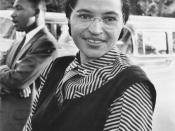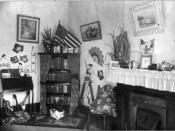John Howard Griffin was a journalist and a specialist on race
issues. After publication, he became a leading advocate in the Civil
Rights Movement and did much to promote awareness of the racial situations
and pass legislature. He was middle aged and living in Mansfield, Texas
at the time of publication in 1960. His desire to know if Southern whites
were racist against the Negro population of the Deep South, or if they
really judged people based on the individual's personality as they said
they prompted him to cross the color line and write Black Like Me. Since
communication between the white and African American races did not exist,
neither race really knew what it was like for the other. Due to this,
Griffin felt the only way to know the truth was to become a black man and
travel through the South. His trip was financed by the internationally
distributed Negro magazine Sepia in exchange for the right to print
excerpts from the finished product.
After three weeks in the Deep South
as a black man John Howard Griffin produced a 188-page journal covering
his transition into the black race, his travels and experiences in the
South, the shift back into white society, and the reaction of those he
knew prior his experience the book was published and released.
John Howard Griffin began this novel as a white man on October 28,
1959 and became a black man (with the help of a noted dermatologist) on
November 7. He entered black society in New Orleans through his contact
Sterling, a shoe shine boy that he had met in the days prior to the
medication taking full effect. Griffin stayed with Sterling at the shine
stand for a few days to become assimilated into the society and to learn...



Black Like Me
This is one of my alltime favorite books. I first read it when it was first published and then again finding it in a used book store last year. The essay was a good represetation of the book. but perhaps two points could have been mde better. First, the civil rights movement was in its infancy at the time--African Americans were very much second class citizens and most of them and most whites saw no change coming. Second, the real danger to an "uppity" black was hard to overstate. The author, as a black man, did not "know his place." He did not act subserviently enough and would even dare to look at the face of a white woman. Great book--very good essay.
5 out of 7 people found this comment useful.